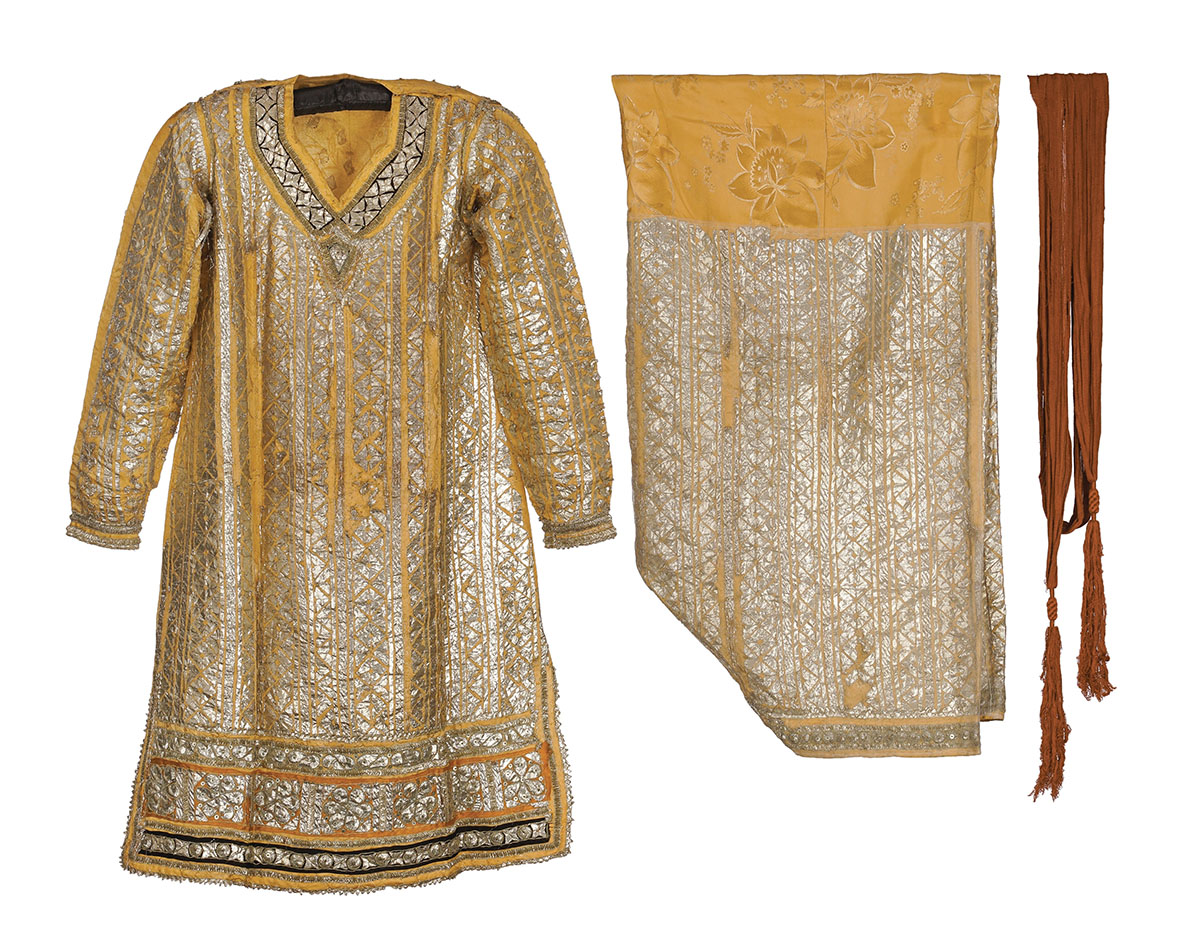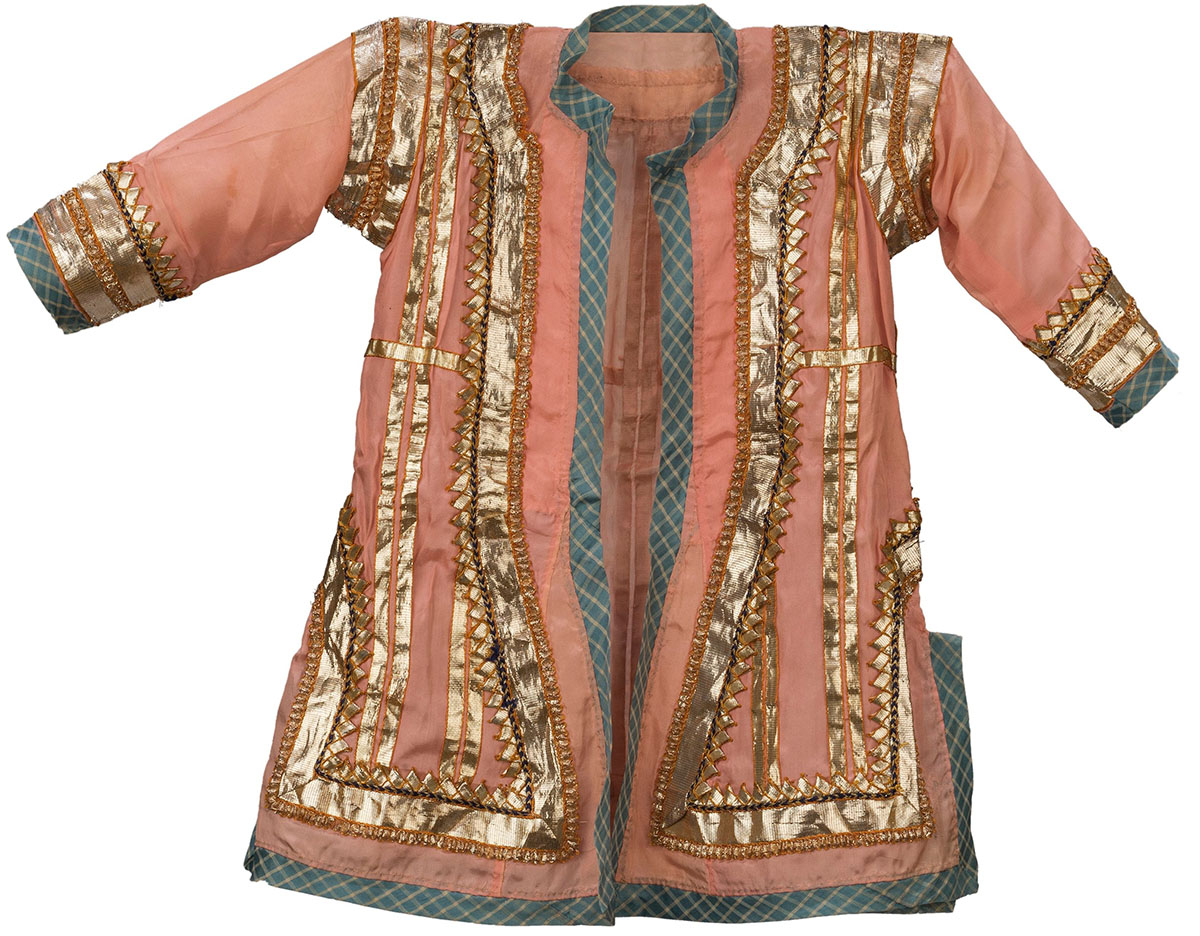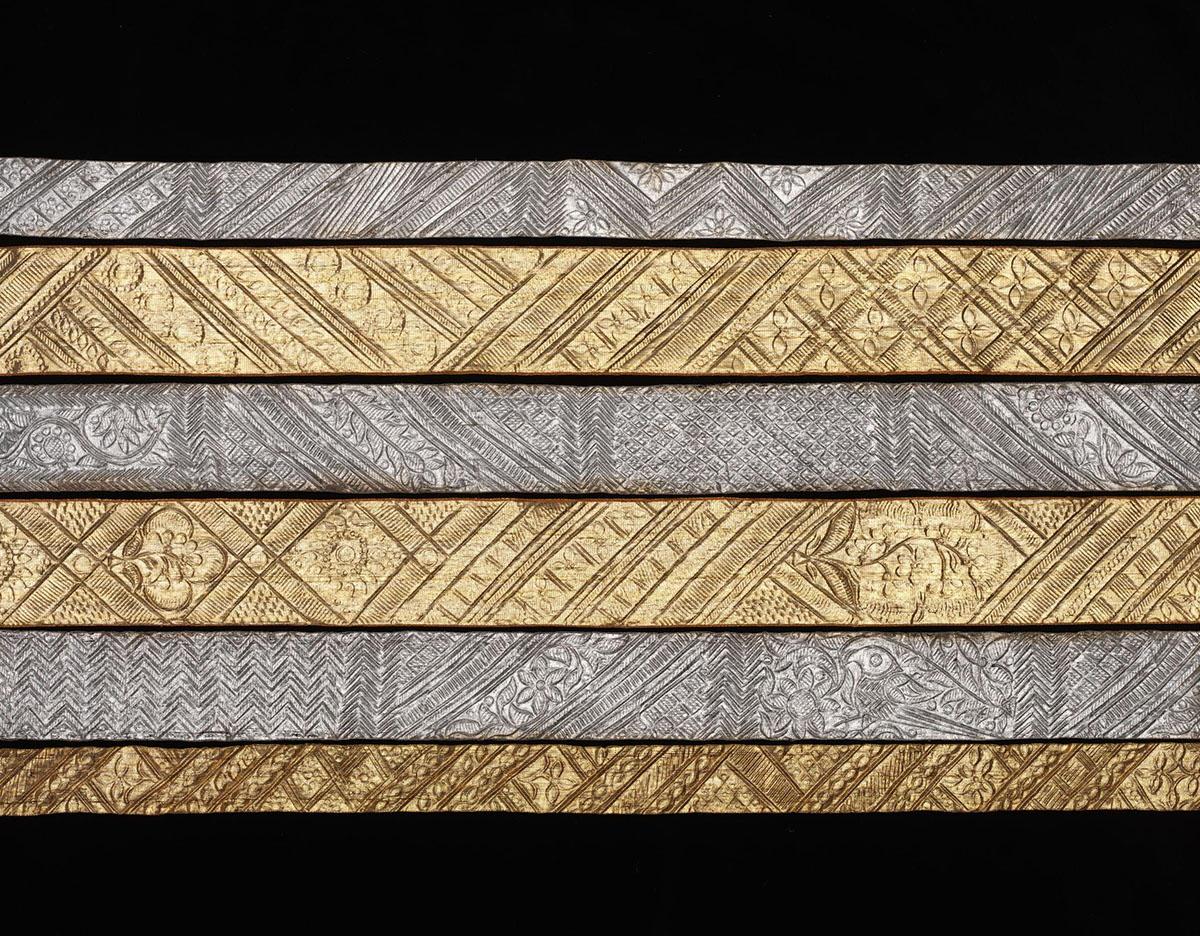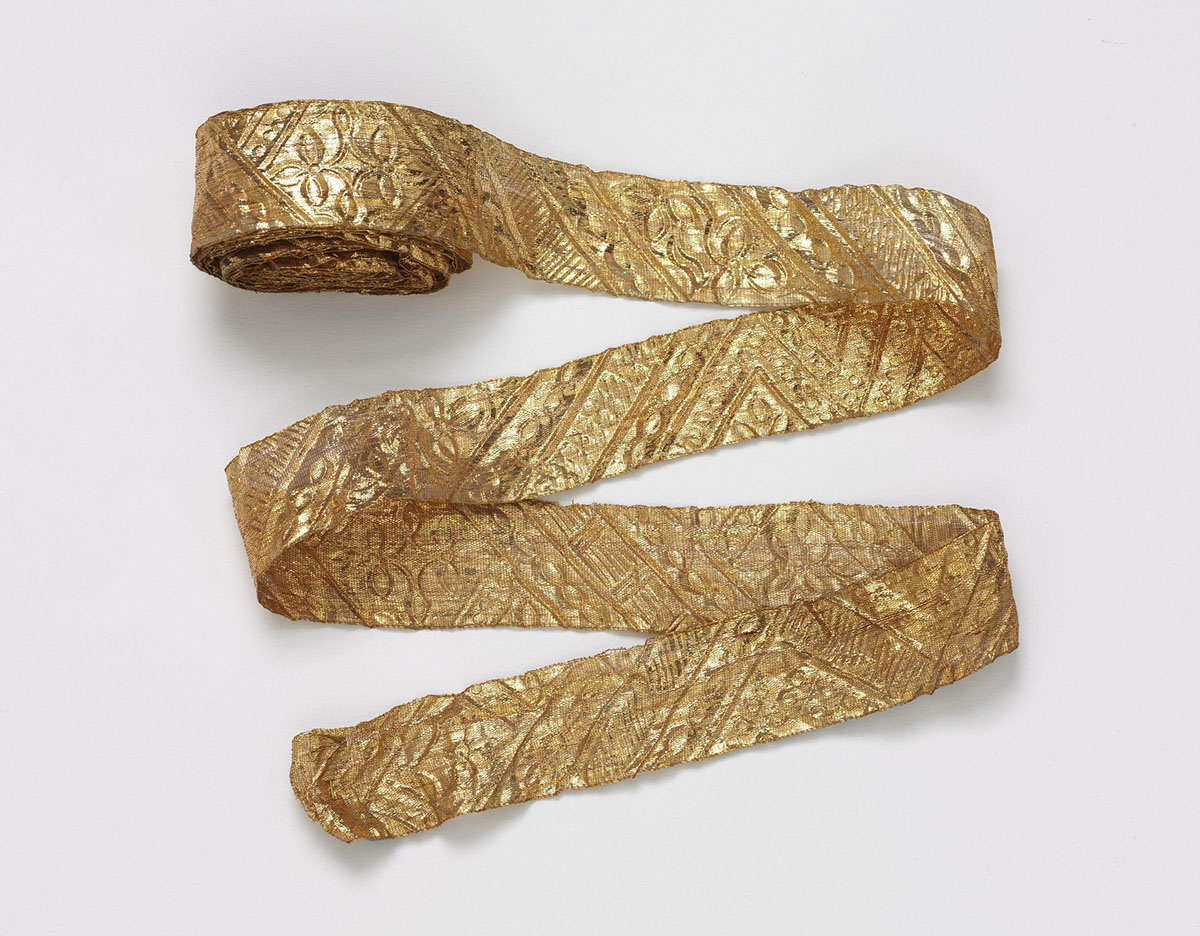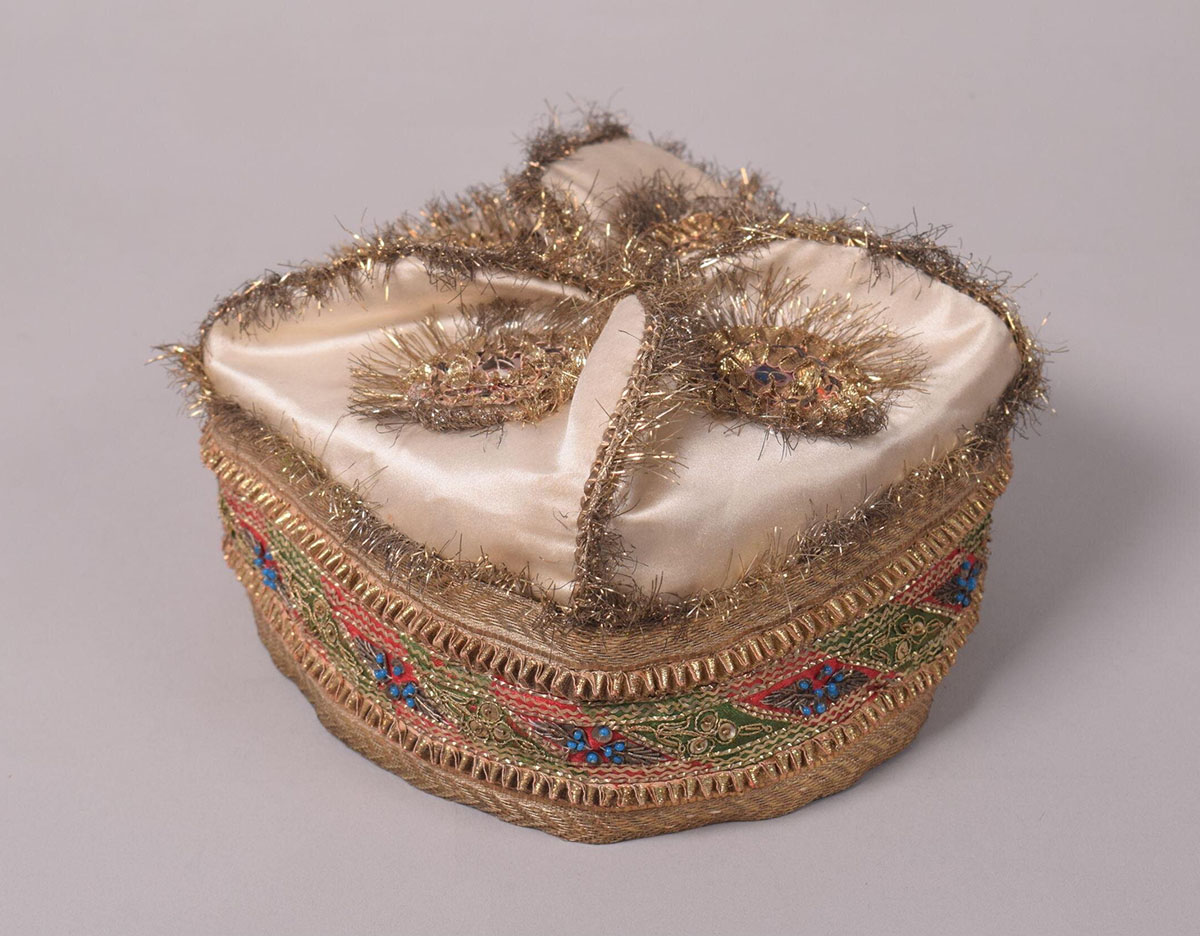ARTICLE
Gota Work
A technique of embellishing textiles and other objects with gold or silver trims, gota work is popular in north and northwestern India, particularly the states of Rajasthan, Gujarat, Punjab and Himachal Pradesh. The trim or braid — gota in Hindi — is woven using flat gold or silver wire and cotton or silk. Considered auspicious and a marker of prosperity, gota is traditionally hand-stitched onto fabrics as decorative borders and motifs using appliqué and embroidery techniques. Generally attributed to Rajput nobility, gota was originally made and used for royal garments and odhnis or scarves for temple idols, and is known since at least the eighteenth century. Today, gota work using lurex, a synthetic fibre, is a popular form of fabric ornamentation, widely used across clothing and a number of other items as diverse as footwear, ceremonial fabrics, and sweet-box wrappers in India.
Gota work evolved as one of many textile traditions across South Asia that have used gold and silver to assert the high social standing, prestige and good fortune of its wearers. Gota uses a flattened gold or silver fibre called badla, which is used in the production of zari, a gold or gold-covered silver yarn used in weaving and embroidery. It is thought to have developed in the same Persianate karkhanas, or workshops, of the Sultanate and Mughal courts in northern India where zari was used for intricate zardozi and ari embroidery since the fourteenth century. With the decline of Mughal power and patronage in the seventeenth century, artisans from these courts moved to provincial courts around India. By the nineteenth century, Jaipur, a significant centre of Rajput power in northern India, had emerged as the main centre for zari and badla production, alongside Lucknow and Surat, and become particularly known for weaving gota. The Rajput courts in Jaipur and Himachal Pradesh, and the Sikh courts in Punjab adopted gota work for garments, headdresses and footwear, and as an integral part of the bridal trousseau. The popularity of gota work here was possibly due to these rulers’ desire for a distinct yet opulent form of fabric embellishment, in the absence of the local silk weaving traditions and lavishly patronised workshops that were essential to support zardozi and ari embroidery.
Further, the Udaipur region of Rajasthan had previously been known for a type of decorative tradition called danka work or korpatti ka kam, in which flat pieces of solid gold or silver cut in various shapes were stitched onto stretched fabric, alongside zardozi work. When used along the hems of odhnis or ghagras, as they typically were, the weight of these metal trims aided the fall of these garments. Gota, besides being cheaper, was a flexible material that was easier to apply onto fabrics in versatile ways, and its low weight meant that the fabric could be much more lavishly embellished without getting too heavy. This made gota work the predominant decorative element on garments in these areas, and a distinctive feature of the poshak, the Rajput women’s ceremonial dress. In the eighteenth century gota work was being produced in the courts and wealthy households of present-day Rajasthan, as well as Lucknow, Mirzapur and Varanasi in present-day Uttar Pradesh and Aurangabad in present-day Maharashtra. It was also associated with a recycling tradition whereby old gota- and zari-decorated garments would be burnt and the metal retrieved to be used on new garments, so that the same gold and silver were passed down generations through textiles.
Gota ribbons were traditionally made on a handloom using the badla as the warp, woven with a cotton or silk weft. Some scholars consider it more likely that the badla formed the weft within a cotton or silk warp instead. The flatness of the badla makes the textile relatively light for its width, and lends it a prominent shine. The textile is woven in different widths, in a plain, satin or twill weave, giving rise to various types of gota. Due to its metallic component, the woven textile can be embossed with various patterns.
Borrowing elements from Mughal art and Indo-Saracenic architecture, gota work employs motifs such as bel (‘vine’), jaali (‘lattice’), buta (‘plant’) and buti (‘herb’). Narrow gota ribbons produced in plain weave are called masya and range from about 0.5 centimetres to 2 centimetres wide. These are folded along diagonals to yield rows of repeating triangles or diamonds, such as beejiya (from the Hindi ‘beej’ meaning ‘seed’), beej bel (‘vine of seeds’) and shakkar pare ki bel (‘vine of a diamond-shaped sweetmeat’) — motifs that represent abundance and fertility. Wider gota woven in a twill pattern are called lappa, and range from about a centimetre to thirteen centimetres in width. These were traditionally used as trims for Rajput women’s ghaghras or skirts as part of the poshak, in what is often called lappe ka kam (‘lappa work’). Seekhiya gota is a thin ribbon, known for its delicate appearance, while gokhru gota embellishments are made by crimping together motifs cut from ribbons with thick wire, or pieces of the metal itself. Gokhru is no longer practised due to the expense and the weight it adds to the fabric. In modern times, gota is woven on electrically powered swivel looms.
Besides borders and trims, individual pieces of gota — in geometric and floral shapes such as patti (‘leaf’), phool (flower) or tukdi (‘piece’) — are appliquéd onto fabric, sometimes alongside embroidery. Phool gota is made by pleating the gota to resemble a flower and appliquéd onto the fabric as part of a larger pattern. In the popular gota patti work, the ribbon is folded into variations of an oval or diamond shape and back-stitched onto the fabric as part of motifs like florets, paisleys and peacocks, before being hammered flat with a wooden implement. Gota tukdi, another appliqué technique, involves cutting the ribbon into floral motifs and sewing them onto the base fabric. Gota appliqué is frequently paired with embroidery, usually along the borders of motifs. In addition to garments, gota work is also used on traditional household furnishings like toranas (auspicious bunting) and juttis, a type of Indian moccasin.
In the twentieth century, the gota work tradition underwent several economic and cultural changes. As India gained independence, princely states and their royal karkhanas began to decline, and gota artisans, hitherto exclusively male, moved their practice to their homes, leading to the inclusion of women in the craft. National schemes such as Training Rural Youth for Self-employment (TRYSEM) implemented in 1979 trained a number of women in gota work, and provided them with the opportunity to work from their homes.
By the late twentieth century industrialisation and mass-produced raw materials such as lurex, a synthetic yarn with a metallic sheen, made gota cheaper and more accessible. While lurex has almost completely replaced metal gota, it has led to the wide popularity of gota work in India’s rural areas. However, due to the lack of actual metal in lurex most contemporary gota work lacks the three-dimensionality that could be achieved by pinching or crimping traditional gota. Gilt, lurex or copper gota remain markers of auspiciousness and festivity, and are widely used across clothing and objects, while the rarity and value of gold and silver gota-embellished garments make these important heirloom objects. Parts of Jaipur city and the villages of Nyla and Khandela in Jaipur district are the major clusters of gota production today.
Bibliography
Our website is currently undergoing maintenance and re-design, due to which we have had to take down some of our bibliographies. While these will be re-published shortly, you can request references for specific articles by writing to hellomapacademy@map-india.org.




